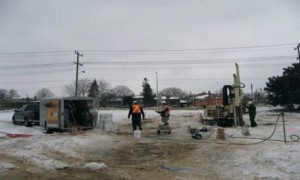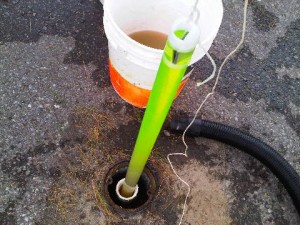OVERVIEW
Surfactants and co-solvents are introduced into the subsurface to transfer chemical contaminants into an aqueous phase where they are more readily remediated using chemical or biological means, or to mobilize contaminants from unsaturated zones or fractures so that they can be extracted or remediated in-situ.
Surfactants are compounds, similar to soaps, which lower the surface tension of liquids and increase the mobility of chemicals.
Co-solvents, such as alcohol, also increase the solubility and thus mobility of various chemical contaminants, including chlorinated solvents and petroleum hydrocarbons.
Tracers are conservative compounds, elements or solutions that are used to map out groundwater flow patterns, bedrock fracture zones, monitor subsurface groundwater travel times or confirm injection areas of influence in the subsurface. Tracers can range from sodium or potassium bromide, to dyes, to distilled water, or salt water, depending on the formation and objective of the tracer study.
 Vertex is one of Canada’s most experienced applicators of surfactants and co-solvents for the remediation of soil and groundwater. Geologic environments in which Vertex has implemented surfactant-based remedial programs include:
Vertex is one of Canada’s most experienced applicators of surfactants and co-solvents for the remediation of soil and groundwater. Geologic environments in which Vertex has implemented surfactant-based remedial programs include:
- Fractured rock
- Glacial till
- Sand and gravel deposits
- Silt and clay
The types of surfactant and co-solvent approaches that can be considered for utilization at a site include:
- Surfactant Flushing
- Surfactant-Enhanced Chemical Oxidation
- Surfactant-Enhanced Bioremediation
- Alcohol Flushing
- Sulfur Hexafluoride (SF6)
 COMPOUNDS TREATED
COMPOUNDS TREATED
Compounds that surfactants and co-solvents can be used effectively for include:
- Chlorinated ethenes (PCE, TCE, DCE, VC, etc.)
- Chlorinated ethanes (TCA, DCA, etc.)
- BTEX
- PAHs
- Petroleum hydrocarbons
EXPERIENCE
The key to the successful design and implementation of a surfactant-based program is to understand the hydrogeology and geochemistry of the system. Traditionally the standard remedy for groundwater contamination was pump and treat until MacKay and Cherry (1989) noted that there were persisting sources of contamination that were being ineffectively remediated by pump and treat. Due to numerous chemical and hydrologic reasons it was recognized that the removal of non-aqueous phase liquids (NAPLs) by pump and treat is limited by the dissolution of this separate phase of contamination into the groundwater. Thus began the search for a method to overcome this mass transfer limitation posed by NAPLs including the use of co-solvents and surfactants. The attraction of using co-solvents and surfactants is their ability to increase the solubility and mobility of the compounds of concern thus allowing for faster remedial time frames. Surfactants and co-solvents that Vertex staff have experience with include:
- Chelants
- Ivey-Sol
- Triton X-100
- Alcohol
- Methanol
 Dyes or conservative tracer testing can also be utilized at sites to allow a better understanding of geology and hydrogeology, especially in fractured bedrock formations. Vertex staff has experience in the application of the following dyes and tracers:
Dyes or conservative tracer testing can also be utilized at sites to allow a better understanding of geology and hydrogeology, especially in fractured bedrock formations. Vertex staff has experience in the application of the following dyes and tracers:
- Fluorescent Dyes
- Bromide and Chloride
- Stable Isotopes
- Distilled or de-ionized water
- Salt water
Vertex combines strong theoretical understanding with practical experience to properly plan and implement the right remedial program for your site. Selecting Vertex to undertake your remediation project allows you to access a wealth of in‑situ remediation knowledge and experience.

